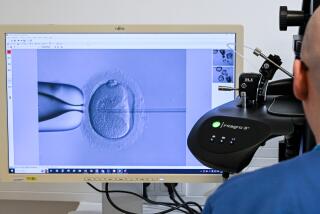Lamb fetuses can now grow in artificial wombs. Will humans be next?
- Share via
When babies are born, they draw their first breaths. Those gulps of oxygen trigger the lungs to stop developing.
When babies are born prematurely, the same thing happens. But a preemie’s lungs are critically underdeveloped. Scientific advancements have made it possible for babies born as early as 22 or 23 weeks to survive, but they suffer from high rates of chronic issues. Babies born that early have only a 30% to 50% chance of survival. If they do make it, they face a 90% chance of developing a serious condition related to prematurity.
An artificial womb developed by researchers at the Children’s Hospital of Philadelphia could be a way to let premature babies get that much-needed extra time for their lungs and other critical organs and systems to develop. It could also reduce the estimated $43 billion the U.S. spends every year caring for premature infants.
A study published this week in the journal Nature Communications explains how it works.
The artificial womb, called the Biobag, is a closed-fluid system that uses a pumpless circuit to continuously circulate electrolyte-rich fluids via the umbilical cord in a polyethylene bag. In essence, it’s a big sterile Ziploc bag with tubes coming out of it.
Most premature babies are delivered by caesarean section. Inside the womb, the lungs are deflated, and the baby gets oxygen from the umbilical cord. Upon leaving the mother’s body, the change in temperature and environment triggers the lungs to inflate and, within about 10 seconds, the baby takes its first breaths. The umbilical cord is cut and clamped. Then the child is put on a ventilator in an incubator to stay alive. The baby spends weeks or months in the neonatal intensive care unit fighting for her life.
(For a first-person perspective on what it’s like to have an extremely premature baby, you can read this Tampa Bay Times multi-part series written by a mother who delivered just before the 24-week mark.)
With the new system, doctors would begin a C-section by making a small incision and giving the fetus a dose of a narcotic. Doctors would connect the system’s circuit to the veins in the umbilical cord. Once blood was flowing properly through the circuit, the umbilical cord would be detached from the mother. The baby would then go into the Biobag.
Researchers at the Philadelphia children’s hospital have been testing their invention on sheep fetuses. Dr. Alan Flake, a fetal surgeon and director of the hospital’s Center for Fetal Diagnosis and Treatment, said lambs have been used for fetal physiological research for 50 to 60 years because of their similarity to humans.
In the experiments, sheep fetuses were delivered at 100 to 115 days of gestation, which is roughly equivalent to the 22- to 24-week mark for human fetuses. Once delivered, the lambs were submerged in the Biobag and monitored for as long as four weeks.
Inside the artificial womb, the lambs did just what they would have been doing in utero: breathing, sleeping, swallowing, moving around and, most importantly, growing. Echocardiograms showed normal heart activity. Brains grew at the appropriate ratio for the animals’ size. The lambs fattened up and grew wool. Overall, the animals “generally appeared comfortable and non-distressed,” according to the study.
After up to four weeks in the artificial womb, the eight lambs incubated in the final Biobag prototype were “born” and put on a ventilator to begin breathing on their own. They were “surprisingly stable,” the study reported. Organ growth and maturation, including of the lungs and brains, were comparable to control lambs born via C-section at the same gestational age.
Despite this success, the researchers acknowledged that parents might find it a little jarring to see their babies floating in a bag. But, the study noted, the alternative is the ventilator in the neonatal intensive care unit.
Babies would only stay in the artificial womb for a few weeks — as long as it takes for their lungs and other systems to develop, said Dr. Emily Partridge, a researcher at the Philadelphia hospital.
“Our intention would not be to support them on our system until they are a chubby 40-week gestation babe,” Dr. Partridge said in a video released with the study. “The idea is to bridge the rough patch when they’re really struggling and carry them through to a point where they can do OK.”
Of course, the study points out, lambs and human babies are not exactly the same. And though the lambs’ brains looked healthy, there are limitations on how well you can measure a sheep’s neurological function.
Fetal lambs are about three times larger than human fetuses, so the entire Biobag system would have to be sized down for preemies. The synthetic amniotic fluid hasn’t been perfected yet. Finally, as currently designed, the system wouldn’t work for babies delivered vaginally.
But researchers will be addressing those issues soon. Flake, the director of the research center, said things are moving fast.
“We’re in the process of interacting with the FDA, so it’s not impossible that we could be doing a clinical trial one to two years from now,” he said.
Follow me on Twitter @jessica_roy and “like” Los Angeles Times Science & Health on Facebook.
MORE FROM SCIENCE
Waiting for Cassini: Scenes from a late night at NASA’s Jet Propulsion Laboratory
Does Parkinson’s disease begin in the gut? New research suggests it does
130,000-year-old mastodon bones could rewrite story of how humans first appeared in the Americas







